“ There’s no other place I’d rather be.” – Anthony Davis, when discussing the city of New Orleans at All-Star weekend, 14th February 2014.
In the two years since New Orleans won the draft lottery there has been mass transformation to a franchise fighting to get back into the playoffs. The team has evolved its roster with a core group of young veterans mixed with a variety of key role players.
The catalyst for change is not in any one of these details, it’s in the emergence of their young rising power-forward Anthony Davis.
At just 21 years of age he has already won a gold-medal, already been to an All-Star game and already led the league in shot-blocking. He’s a terrifying force to be reckoned with and there’s little anyone can do to stop him.
What makes the New Orleans Pelicans such an enigmatic team is the level at which Davis can reach. Nobody is quite certain how good he could be with the cliché moniker, “the sky is the limit” being perpetuated around the league.
But the NBA truly is Davis’ oyster, he can be as good as he wants to be and choose to be any type of player he wants. The skill-set is still as diverse and bountiful as it was coming in to the league.
The 2013-14 season was a reflection of just how far Davis has come in so short a time.
What Did His Season Compare To?
To get a grasp as to just how ridiculously amazing Anthony Davis played let us filter the results for the following categories:
- PER >/= 26
- Points Per-Game >/= 20
- Blocks Per-Game >/= 2.8
- Free-Throw Percentage >/= 70%
- Minutes Qualified
A total of 5 players make the list, they are:
- David Robinson (6)
- Kareem Adbul-Jabaar (4)
- Tim Duncan (1)
- Hakeen Olajuwon (1)
- Anthony Davis (1)
The brackets in this case signifies how many times a player had such a season. Want to guess who the youngest was to achieve such a feat? You guessed it, Anthony Davis at 20 years of age. The next closest was David Robinson at 24 years old (this was his rookie season too).
It captures an overall sense of just how spectacular Anthony Davis’ season was. Every single one of these players are Hall of Famers.
Extending the comparisons further using the table below we can judge just how he fares when placed next to some of the other league’s leading power-forwards.
The two tables above clearly demonstrate that Anthony Davis belongs in the conversation as best power-forward in the entire NBA. At his age he is already challenging other big-men for best in the league. The discussion is valid; Davis was 15th in the league in double-doubles, 15th in scoring, 2nd in PER and 3rd in win share per-48 among big-men.
Further to that if we look at where the others were in their careers at the same point as Davis it becomes clear that there’s plenty to be excited about.
For instance at the same age, Davis posts the best PER, best block percentage, scored the second most points and had the best offensive rating and win-share per-48. Defensively he still has a ways to develop, but all of the comparing big-men struggled early in their careers with that aspect of the game.
“Only three men have ever lead their teams in the following categories in a single season: Points, Rebounds, Blocks, Steals, and FG%. Looking at this roster and projecting forward, Anthony Davis could easily become the 4th.” – Michael McNamara October 20th 2013.
The Stretch
Davis was so close to doing something very few had done before: lead their team in points, rebounds, blocks, steals and FG%. Unfortunately he could not lead the team in the last category, that title went to Greg Stiemsma.
“The Stretch” refers to the series of games that Davis played in March where he was simply unstoppable. Everyone was in awe at how easily he dominated his opponents getting every look he could think of. In this period the Pelicans faced the Lakers, Bucks, Nuggets, Grizzlies, Trail Blazers, Celtics, Hawks, Heat and Nets.
Every night, fans witnessed a player becoming completely aware of his ability to be the best amongst his peers. Against the Heat, a likely contender for the NBA championship, he demanded the ball late in the game and he led his team to victory.
When playing Boston he took a game winning shot and made it before leading the Pelicans to an overtime victory.
Over the nine game stretch he averaged 31 points, 13.5 rebounds, 2.6 blocks, shot 57 per cent from the field and 86 per cent from the free-throw line. It was a thing of beauty to watch a young player dominate against much more experienced opposition.
His Team and Their Chemistry
Bill Simmons: I really like when you play small ball, with you at the 5 and him [Ryan Anderson] at the 4 and then the three guards. But it doesn’t seem like they always do that. What fails about that lineup that makes them not want to play it?
Anthony Davis: Defense. *Chuckles* … . Our defense in that group is terrible. I don’t know why… He [Monty Williams] wants to play that group a lot, but we got to learn how to play better defense with that unit. – Anthony Davis and Bill Simmons | B.S. Report, 14th February 2014.
The New Orleans Pelicans are well on their way to developing their roster around Anthony Davis. Tyreke Evans does an excellent job of pushing the tempo off of steals and blocks. Jrue Holiday scores and distributes the ball evenly. Ryan Anderson spaces the floor. Eric Gordon slashes and handles the ball.
But no one is quite sure how it all fits together.
It presents a challenge for coach Monty Williams to figure out how to get the most out of the players on his roster. With Anthony Davis on the floor the Pelicans were +1.1 overall. Fans might be surprised to see that he played 58 per cent of the time at power-forward with 42 per cent at center.
Table 1.3 — The most frequent New Orleans Pelicans lineups involving Anthony Davis.
The above table illustrates who Anthony Davis played with the most. None seem to be very effective outside of the 5th most common. This lineup involved the one that many fans believe to be the best. In many respects it’s true, they outscore their opponents, they blocks more shots, get more steals, shoot better overall.
But they make less three pointers (4 less than their opponents overall) and as Anthony Davis pointed out they don’t play consistent defense.
There are very few that believe that Anthony Davis and Ryan Anderson aren’t the best options late in games for the Pelicans. Pairing Davis with Withey seemed productive late in the season. And there were times that Ajinca and Davis worked well in the front-court.
No single answer will solve this puzzle and for Monty Williams it will be an ever changing jig-saw to figure out who works well with his NBA superstar.
The issue this season was that injuries significantly affected Davis’ ability to mesh with the talent assembled on the roster. Tyreke Evans and Davis started to really click towards the end of the season and just goes to show you how important playing together for long periods of time will be.
Jrue Holiday and Ryan Anderson could not play throughout the season and the team could never find a groove. There were times when it appeared that this team was starting to click, as GM Dell Demps said, “At times, we were unguardable.”
But finding the right players to surround Davis is going to be dependent on the right balance of offense and defense and it’s up to both Monty Williams and Dell Demps to figure out how to do that.
His Case for Most Improved Player
The New Orleans Pelicans tried to make a case for Anthony Davis as the most improved player in the league. They might of been right, but they couldn’t stop Goran Dragic from taking the honor.
Davis had an amazing season. He was an All-Star and showed a remarkable ability to dominate games in a variety of ways. Dragic also replicated this in Phoenix, albeit with a slightly different style. The Suns were in the playoff hunt until late in the season when Dallas did just enough to get in.
This may seem trivial for the “Most Improved Player” award but it’s not. National analysts usually allocate awards based on team performance and the Suns were a much better and healthier team.
Across most statistics both Davis and Dragic fared even. Both players had near equal improvements in a variety of categories. It’s important to note that Dragic’s offensive efficiency was vastly better than Davis’. The reason for this was because Goran was able to shoot better from three.
Overall Davis had a very plausible case to be Most Improved Player of the year, but so too did Dragic.
His Best Game of the Season
I can’t decide which game was his best. Was it the Portland game? Or perhaps it was against the Heat? I’m going to go with the Celtics game when he posted a 40-20 game and pushed the Pels to victory in overtime.
As far as games go it doesn’t get much more awesome than this. Sure, it was against a pretty average opponent but he dominated them and when the game was on the line he wanted the ball in his hands.
His Game Is Ever Evolving
When a player develops he must add areas to his game. Offensively Davis seems to be making strides. His shot seems improved, he’s diversifying his isolation game and he’s growing chemistry in the pick and roll with certain team mates.
Defensively things are promising, but far from perfect. His pick and roll defense can be inconsistent at times with Davis not containing the ball-handler and forcing a reset of the opponents set. Teams have also worked out the best way to score against New Orleans is to take Davis away from the basket. This is as much a coaching issue as it is a players’, however it’s tough when the best shot blocker on the team is often found very far away from the basket.
Davis’ game has indeed evolved. If we glance at his shooting we can already see a marked improvement from his rookie season.
While these are less than ideal, comparing against his peers we can understand just how far he’s already come in his jump-shooting:
Table 1.5 — Anthony Davis vs. the avg of the listed players in jump-shooting by range for 2013-14.
Though it’s an aspect of his game that is concerning to a degree. Michael McNamara previously discussed at length what adding a jump-shot might do for Tyreke Evans and the same could be said about Davis.
His ability to finish in traffic is right up there with the best. He draws contact and is able to contort his body in ways which prevents the defender from even having a chance. Though developing this aspect of his game is vital for his longevity in the league. Taking sustained hits is never really a positive thing over the long term.
For Davis to expand his game his must be creative and luckily that’s something he’s already starting to do.
Graph 1.1 – Anthony Davis shot type 2012-13 vs. 2013-14
In the above graph Davis is already starting to isolate, post-up and spot up more. He’s shooting less as the pick and roll man and he’s cutting less as an off the ball player.
However this information isn’t quite useful without his performance in each category.
Graph 1.2 – Anthony Davis shot type points-per-possession 2012-13 vs. 2013-14
Davis shot more from isolations and as the post-up option and he did so by shooting better. His isolation was at 36% compared to 26% in 2012. His post-up game was at 40% compared to 25% in 2012. The numbers keep going on and on.
What this means is that the Pelicans are running a lot more of their sets through Davis. It’s likely the coaching staff see’s Davis as the filter through which their offense flows. If this is the case it’s something to be excited about, but it’s not without its limitations. Putting the ball in Tyreke Evans’ hands proved to be a winner towards the end of the season, so keeping a diversity of offensive functionality will be key moving into the future.
The one aspect which stands out above all others in the two graphs that may not be clear, is Davis’ ability to finish in transition. He was the 4th best player in the entire NBA when finishing in transition in 2013-14. He was the 2nd best in 2012-13.
This goes a long way towards rejecting Monty Williams’ desires to slow the tempo down. His top player is at his best when you push the ball, plain and simple.
There’s two sides to every argument which is why it’s important to look at how he’s fared defensively.
Table 1.5 – Anthony Davis defensive possessions individually faced 2012-13 vs. 2013-14.
The majority of the time Davis faced post-ups and spot-up situations. In those instances he played fairly well, though not overly outstanding. His defensive rank (in terms of PPP) jumped from 401st in the league to 118th. There’s something to be said for this as Davis grows into the league. Monty Williams has also made no secret of how tough players find his defensive schemes. This is also evident by the lackadaisical defensive numbers for the Pelicans.
Further behind the numbers there are patterns quickly emerging from Davis’ game. He’s reliant heavily on his ability to drive left which is a plus but appears far too reliant on it at times. There’s also a question about his discipline falling for pump-fakes. There’s been a noticeable difference, compared to last year, with Davis’ discipline to not fall for it every time.
Though these are minor critiques. Davis’ ceiling is higher than ever and quantifying it is no easy task. Many might say that developing each aspect of his game should take time and go through due process, but Anthony Davis’ waits for no one.
Next Season and Beyond
There is plenty for Davis to work on throughout the off-season. He needs to continue to get stronger and develop his lower body and core strength. His isolation and post up games continue to need refinement. Also continuing to build on his jump-shot will be just as vital.
Though it’s important to remember what got Davis to the position he’s currently in. The reason why he’s so good at what he does is because he’s able to play freely and with a style unique to his own. Boxing him in with notions of Tim Duncan and LaMarcus Aldridge in mind can do as much harm as good.
The most important aspect that many don’t consider is Davis’ defensive game. This is an area which he hasn’t made the world dominating strides that many predicted heading into his rookie season. The NBA is much more complex and fast-paced and as such Davis’ ability to defensively impact the game hasn’t been as significant as his offensive one. Beyond his first two seasons it is this area of his game which will be the most intriguing and likely will affect his place among the NBA’s elite.
To read past articles from our Season in Review series, click here.
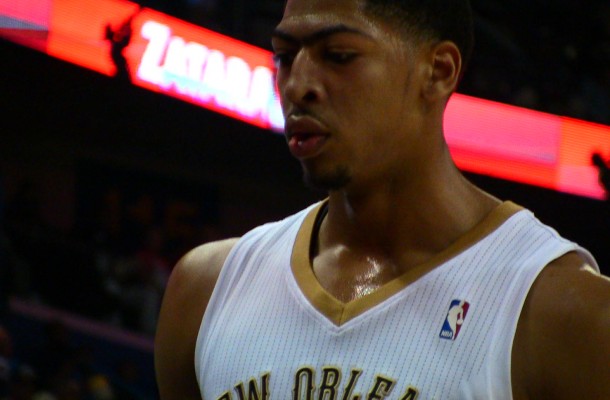

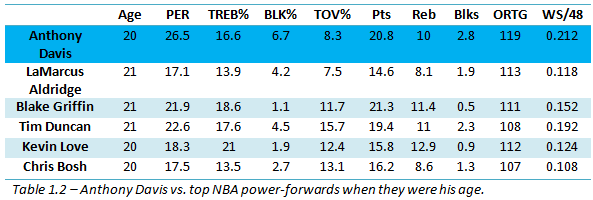
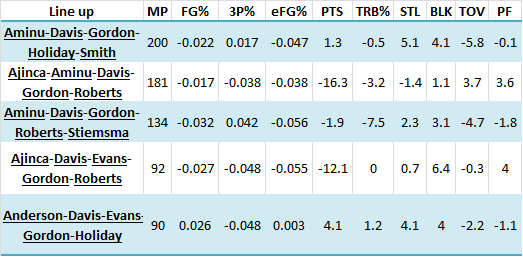


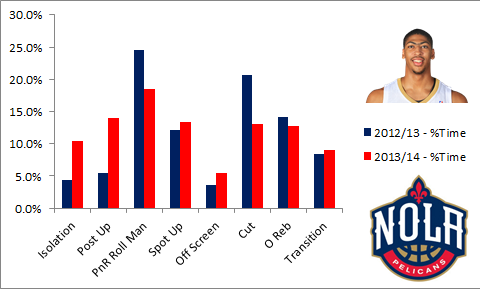
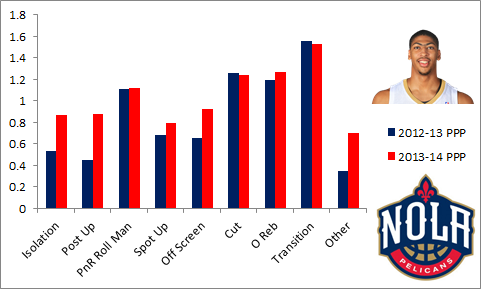
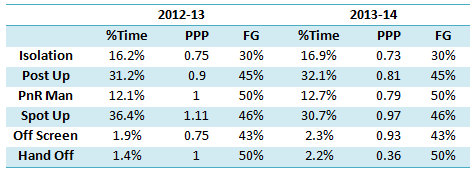
3 responses to “Season in Review: Anthony Davis”
The leap that he took between his rookie & sophomore seasons was astounding. I think he could make close to the same leap in his junior year, shoring up any lose ends to his game. (of which there aren’t many)
The lone gap in AD’s O game has been his inability (clearly till now) to pickup his dribble on hard drives, likely to reverse pivot for a jump hook – a move that is going to result in many more FTs. Really everything is there but the footwork. With the catch-and-spin, the league will be at his mercy. I’m ready!
“The most important aspect that many don’t consider is Davis’ defensive game. This is an area which he hasn’t made the world dominating strides that many predicted heading into his rookie season. The NBA is much more complex and fast-paced and as such Davis’ ability to defensively impact the game hasn’t been as significant as his offensive one. Beyond his first two seasons it is this area of his game which will be the most intriguing and likely will affect his place among the NBA’s elite.”
This is such a great point. I’m glad you brought it up. It takes time adjusting to pros, learning angles and tendencies. And I agree that Monty’s scheme hasn’t done him any favors. But if he becomes the anchor we all think he can be, with his surprising offensive production, he will easily be rubbing shoulders with Durant and LeBron as best in the league.